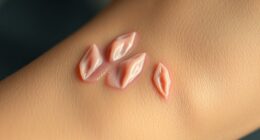With current 3D printing advances, you can now create fully customized, made-to-measure fashion pieces overnight. Using quick, high-speed techniques and efficient materials, designers are producing perfectly fitted, sustainable garments in record time. Incorporating virtual fitting and design adjustments makes customization seamless. While challenges like machinery costs and material limits exist, ongoing innovations are making overnight, tailored fashion more accessible. Keep exploring to discover how these cutting-edge techniques are revolutionizing fast, personalized style.
Key Takeaways
- Advanced rapid printing and curing techniques enable overnight production of custom-fit 3D-printed fashion pieces.
- Digital design files can be prepared in advance for quick, on-demand manufacturing tailored to individual measurements.
- Multi-nozzle and high-speed 3D printers accelerate build times, supporting overnight customization.
- Incorporating virtual fitting and pre-planned workflows reduces errors, ensuring timely completion of personalized garments.
- Sustainable materials and efficient infill strategies optimize print times and material use for quick, made-to-measure fashion.
The Evolution of 3D Printing in Fashion
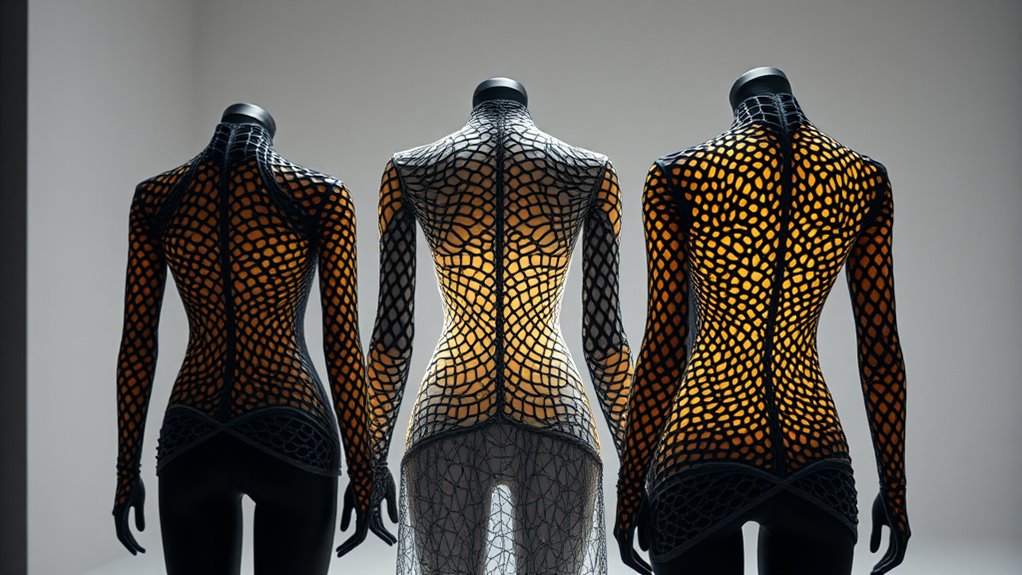
3D printing has rapidly transformed the fashion industry, allowing designers to create complex, customized pieces that were previously impossible or too costly to produce. Understanding its evolution involves exploring key historical developments, such as early prototypes and the shift toward digital manufacturing. Over time, industry collaborations have played a pivotal role, bringing together fashion brands, tech firms, and material scientists. These partnerships have accelerated innovation, enabling designers to experiment with new forms and materials. As 3D printing technology advanced, it moved from basic prototypes to functional, wearable designs. Today, these collaborations continue to push boundaries, making 3D-printed fashion more accessible and innovative. This evolution reflects a blend of technological progress and strategic industry partnerships shaping the future of fashion design. Additionally, continuous advancements in synthetic materials have expanded the possibilities for creating durable, flexible, and lightweight fashion pieces.
Customization and Personalization at Lightning Speed
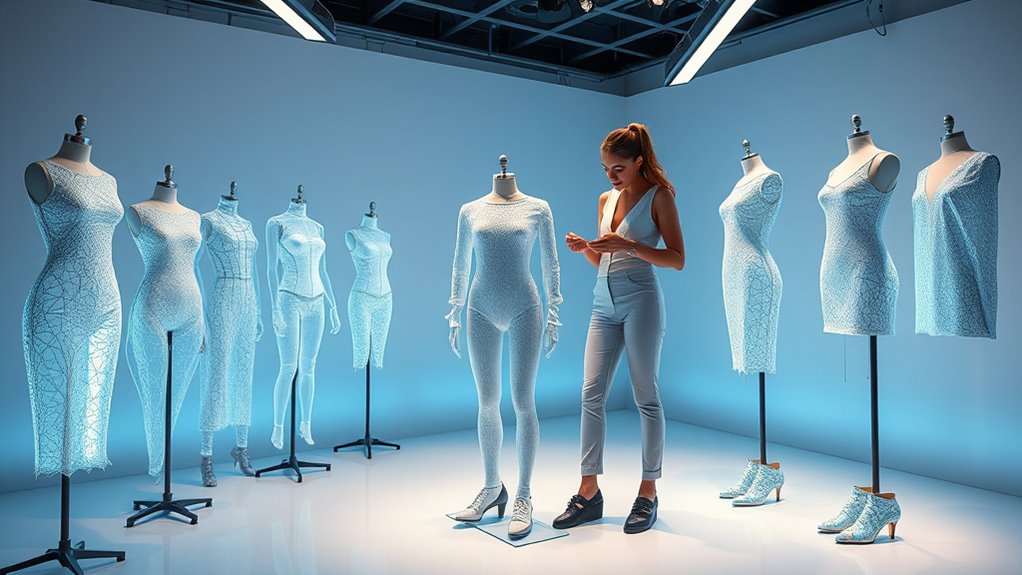
With 3D printing, you can make rapid design adjustments to create exactly what you want. This technology lets you explore unique style options that were difficult or impossible before. As a result, your fashion pieces become truly personalized and crafted at lightning speed. Moreover, embracing limits and constraints can inspire innovative solutions, pushing the boundaries of traditional design processes.
Rapid Design Adjustments
Thanks to the flexibility of 3D printing, designers can now make rapid adjustments to fashion pieces, allowing for quick customization and personalization. You can tweak designs instantly, aligning colors with color theory principles to evoke specific moods or emotions. This speed also supports ethical sourcing, as you can choose eco-friendly materials and adjust designs to reduce waste without delays. Vetted Halloween products offer a variety of themed costumes that can be customized for unique looks. Here are three ways this benefits you: 1. Instantly modify colors and patterns to match personal style or seasonal trends. 2. Quickly adapt designs based on customer feedback or new ethical sourcing options. 3. Minimize waste by making precise adjustments, reducing environmental impact.
This ability to swiftly refine designs enhances both your creative control and your commitment to sustainable fashion.
Unique Style Options
Imagine customizing your fashion pieces in real time, creating a look that’s uniquely yours within moments. 3D printing allows you to personalize designs swiftly, from tweaking intricate patterns to choosing color palettes that match your mood or style. With this technology, you can experiment with bold hues or subtle shades in seconds, making each piece truly one-of-a-kind. Trend forecasting tools help you stay ahead, ensuring your customizations align with the latest styles. Whether you want vibrant, eye-catching colors or muted tones, the process is instant, giving you full control over your fashion choices. This rapid personalization means you can adapt your wardrobe on the fly, reflecting your evolving tastes and personality without delay. It’s fashion, tailored precisely to you, at lightning speed. Adherence to a timeline can be crucial for managing production and delivery schedules, ensuring your custom pieces arrive promptly and meet your expectations.
Materials and Techniques for Overnight Production
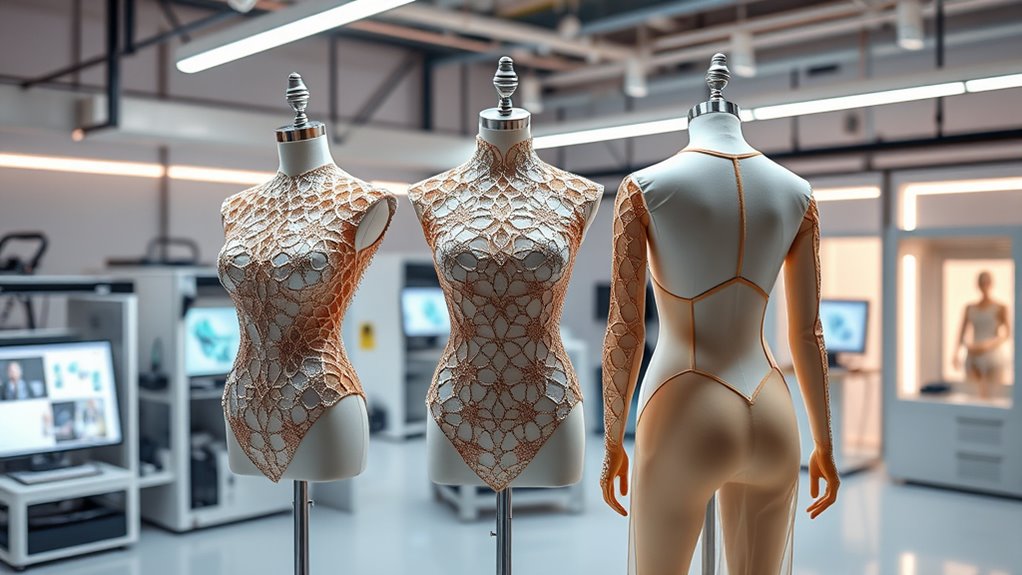
You can produce fashion pieces overnight by using rapid material curing techniques that speed up hardening times. Accelerated printing methods, like multi-nozzle or high-speed printers, help you complete designs faster. Flexible fabric technologies enable you to create comfortable, adaptable garments in record time. Incorporating advanced tuning techniques similar to those used in vehicle modifications can optimize the production process for better precision and efficiency.
Rapid Material Curing
Rapid material curing is essential for transforming 3D-printed fashion pieces into market-ready products within a short timeframe. Efficient curing techniques ensure the durability and flexibility of synthetic fibers, allowing you to meet tight deadlines. Here are three key methods:
- UV Curing: Uses ultraviolet light to instantly solidify resins, speeding up production while maintaining high-quality finishes.
- Heat Curing: Applies controlled heat to accelerate polymerization, ideal for materials compatible with dyeing processes.
- Post-Processing Accelerants: Chemical agents or catalysts that enhance curing speed without compromising material integrity.
These methods help you optimize dyeing processes, ensuring vibrant, long-lasting colors. Quick curing not only reduces turnaround time but also allows for rapid adjustments, making overnight production feasible and efficient.
Accelerated Printing Methods
Building on efficient curing techniques, selecting the right printing methods can dramatically shorten production times for 3D-printed fashion pieces. Techniques like continuous fiber fabrication and multi-nozzle printers enable faster layer deposition, reducing overall print duration. Using virtual fitting early in the design process helps you identify ideal shapes quickly, minimizing trial and error. Rapid printing also aligns with fashion forecasting, allowing you to respond swiftly to trends and deliver customized pieces overnight. By optimizing print parameters and employing high-speed methods, you can produce complex, well-fitting designs without sacrificing quality. Implementing high-pressure techniques further accelerates production, making it possible to meet tight deadlines and deliver on-demand fashion that’s both innovative and precisely tailored. These accelerated methods empower you to meet tight deadlines and deliver on-demand fashion that’s both innovative and precisely tailored.
Flexible Fabric Technologies
How can flexible fabric technologies enable overnight production of 3D-printed fashion pieces? These innovations harness advanced materials that combine fabric-like flexibility with 3D printing. This allows you to quickly produce custom-fit garments with high design flexibility. Here are three key aspects:
- Fabric innovation: New materials mimic traditional textiles, offering stretch, durability, and comfort in a single layer.
- Rapid layering: Techniques like inkjet or fused deposition enable swift creation of complex, flexible structures.
- On-demand customization: Flexible fabrics adapt to body contours instantly, reducing post-processing time.
– Positive customer reviews highlighting durability and performance contribute to the development of high-quality materials suitable for overnight production.
Designing for Efficiency: From Concept to Print

Designing for efficiency in 3D-printed fashion involves streamlining your concepts to minimize material use and printing time without sacrificing quality. Focus on optimizing your designs for rapid production, which reduces delays in the supply chain and allows for quick delivery. Using lightweight structures and hollowed-out sections helps save material and speeds up printing. Consider how your designs can support effective marketing strategies by showcasing innovative, sustainable pieces. Planning ahead ensures your files are print-ready, reducing errors and waste. Additionally, understanding equipment setup can help you achieve consistent results and improve overall workflow efficiency. Here’s a quick overview:
| Aspect | Benefit | Tip |
|---|---|---|
| Material Optimization | Faster production, less waste | Use minimal infill and lattice structures |
| Design Simplification | Quicker print times | Avoid overly complex geometries |
| Supply Chain Efficiency | Faster turnaround, better inventory management | Streamline models for smooth manufacturing |
Challenges and Limitations of Rapid 3D-Printed Fashion
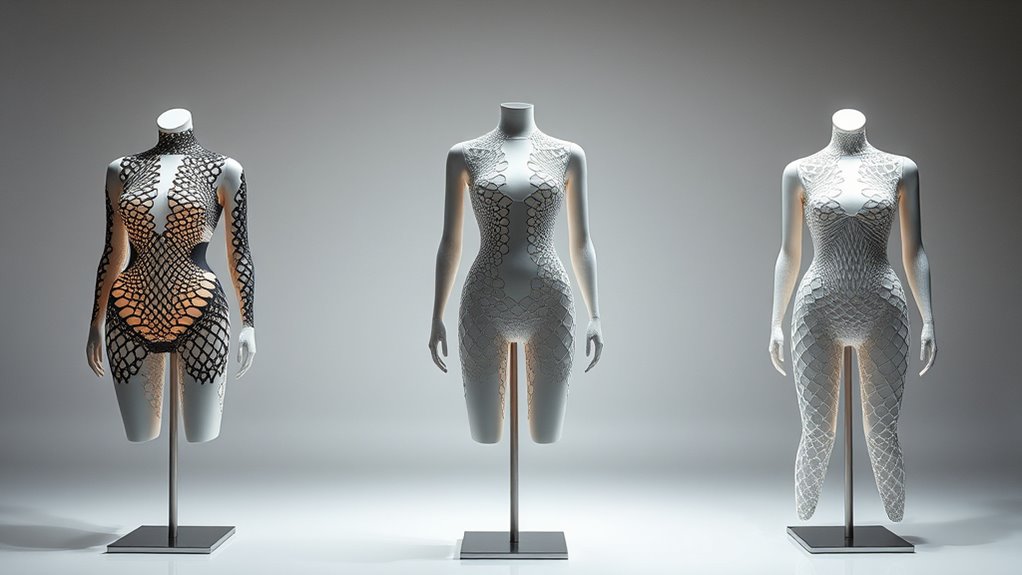
While rapid 3D printing offers exciting opportunities for innovative fashion, it also presents significant challenges that can’t be overlooked. First, the costly machinery required for high-quality prints can be a barrier, making it difficult for smaller designers to access the technology. Second, limited flexibility in materials and designs restricts creativity, as not all fabrics or textures can be replicated effectively. Third, the speed of printing may not always meet production demands, especially when complex, detailed pieces are involved. These limitations mean that, despite its potential, rapid 3D-printed fashion still faces hurdles in scalability, affordability, and versatility. Additionally, integrating leadership skills such as strategic planning and innovation management is essential to overcoming these obstacles and advancing the industry. Overcoming these issues is vital for broader adoption and transforming how fashion is created and experienced.
Sustainability and Environmental Impact

Is 3D-printed fashion truly more sustainable than traditional methods? It can be, especially when you consider recycling initiatives that reduce waste. Unlike conventional manufacturing, 3D printing uses only the material needed, minimizing excess fabric or scraps. This approach helps lower the ecological footprint of fashion production. Additionally, some 3D printing materials are recyclable, allowing you to reuse or repurpose components instead of discarding them. However, it’s essential to recognize that not all 3D printing processes are eco-friendly; energy consumption and material sourcing matter. By choosing sustainable materials and supporting recycling initiatives, you can make a more environmentally conscious decision. Sustainable practices can significantly enhance the eco-friendliness of 3D-printed fashion. Overall, 3D-printed fashion offers promising opportunities to reduce environmental impact, but it requires mindful implementation of eco-friendly practices.
Future Trends and Potential Innovations
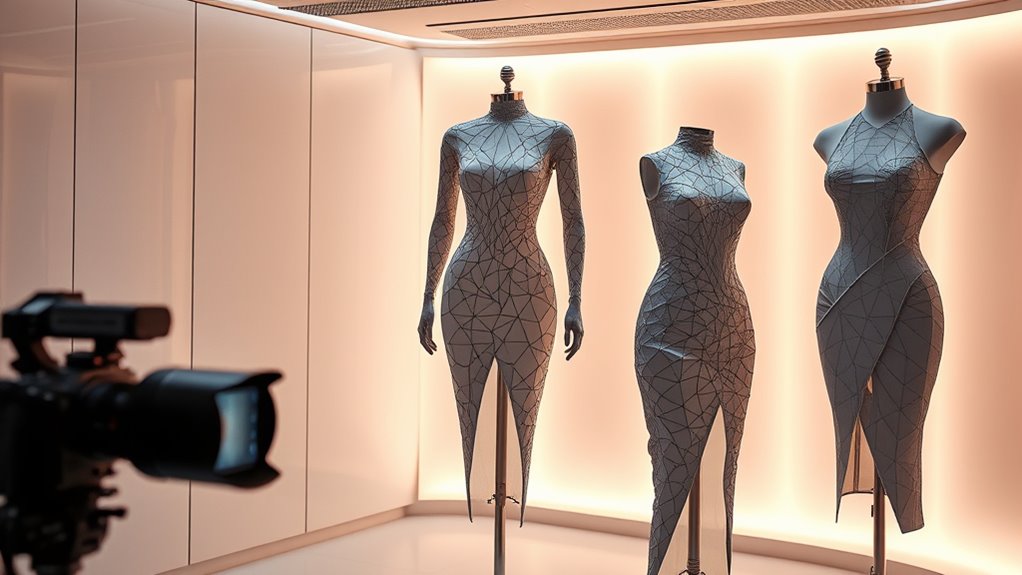
As 3D printing continues to evolve, innovative technologies promise to reshape fashion’s future. You can expect advancements like:
- Wearable technology integrated seamlessly into 3D-printed garments, enhancing functionality without sacrificing style.
- Virtual fitting platforms powered by 3D modeling, letting you try on customized pieces virtually before printing.
- On-demand, made-to-measure fashion that reduces waste and speeds up production, making high-quality, personalized pieces accessible overnight.
These innovations make fashion more interactive and sustainable. Wearable tech not only adds utility but also sparks new design possibilities. Virtual fitting tools ensure perfect fits, reducing returns and waste. Together, these trends will transform how you shop, create, and wear fashion, making it more tailored and efficient.
Frequently Asked Questions
How Do 3d-Printed Fashion Pieces Compare in Durability to Traditional Garments?
You might wonder how 3D-printed fashion pieces compare in durability to traditional garments. Generally, they can be quite resilient, especially when made with sustainable materials designed for strength. Their design flexibility allows for customized, lightweight, and intricate structures that resist wear and tear better. However, the durability varies based on the materials used and the printing process. Overall, with advances in technology, 3D-printed fashion can match or even surpass traditional clothing in longevity.
What Software Tools Are Most Effective for Designing 3d-Printed Fashion Items Quickly?
When designing 3D-printed fashion items quickly, you want software that excels in parametric modeling and material selection. Tools like Rhino with Grasshopper, Fusion 360, and Blender let you create adaptable designs efficiently. They enable you to tweak parameters on the fly, choose ideal materials, and streamline the process. This way, you can rapidly develop custom, well-fitting pieces that meet your style and durability needs.
Can 3d-Printed Fashion Adapt to Different Body Types Instantly?
Think of your body as a unique puzzle, and your clothing as the pieces that fit perfectly. 3D-printed fashion can adapt to different body shapes with remarkable sizing flexibility, especially when integrated with advanced scanning technology. You can get custom-fit pieces almost instantly, making the garment an extension of your body rather than a one-size-fits-all solution. This innovation turns fashion into a true reflection of your individuality.
What Are the Costs Associated With Overnight 3D Printing for Fashion?
When considering overnight 3D printing for fashion, you should do a cost analysis to understand expenses. Material expenses can be significant, depending on the type of filament or resin used. Additionally, you need to account for machine operation costs, labor, and potential waste. While it offers quick production, the overall costs can be high, making it essential to weigh the investment against the benefits of fast, custom-fit pieces.
How Do 3d-Printed Fashion Pieces Hold up in Everyday Wear and Washing?
You’ll find that 3D-printed fashion pieces can be quite durable for everyday wear, especially with proper care. They often feature good fabric flexibility, allowing comfortable movement, and generally retain their color well after multiple washes. However, it’s important to follow specific cleaning instructions, as some materials may be sensitive to heat or harsh chemicals. Overall, with proper care, these pieces can maintain their quality and appearance over time.
Conclusion
Imagine customizing your fashion pieces overnight with 3D printing—it’s faster and more personal than ever. Did you know that the global 3D printing market in fashion is expected to reach $5 billion by 2025? As technology advances, you’ll see more sustainable materials and innovative designs that fit your unique style instantly. Embrace this revolution and stay ahead, because overnight fashion isn’t just a dream—it’s quickly becoming your new reality.










